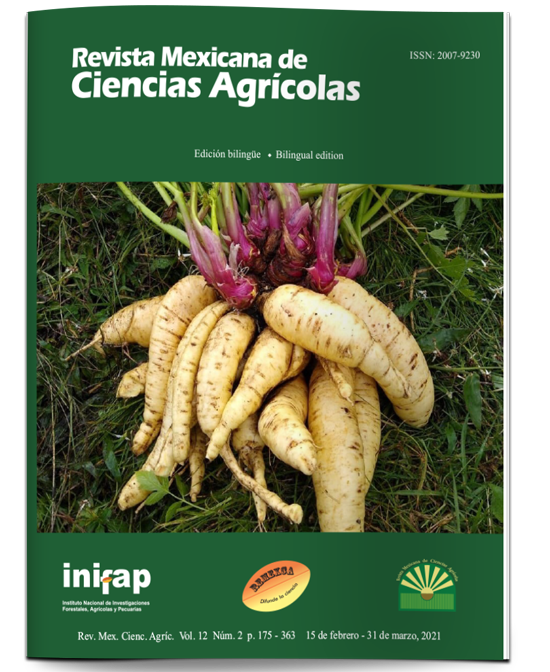Impact of cover, ecotype and endomycorrhizae on morphology and quality of piquin chili
DOI:
https://doi.org/10.29312/remexca.v12i2.2847Keywords:
Capsicum annuum, quality, shadow mesh, solar radiationAbstract
The research was carried out with piquin chili ecotypes from the states of Coahuila, Nuevo León and Zacatecas. Piquin chili plants were evaluated in its second year of production. Two environments were used: a) macro tunnels of white mesh, red, blue, black raschel type with 30% shade; and b) open field with 100% light transmission. 50 spores of a conglomerate of arbuscular mycorrhizal fungi (Glomus mosseae, Rhizophagus intraradices, Sclerocystis coremioides and Gigaspora albida) were inoculated directly to the radical system. A factorial arrangement 5 x 6 x 2 (cover, ecotypes and mycorrhizae) was used and its distribution corresponded to a random block design with four repetitions. The yield and some morphological characteristics of the plant were evaluated such as plant height (AP), stem diameter (DT), root length (LR), fresh plant weight (PFP), dry weight of the plant (PSP), fresh root weight (PFR), dry root weight (PSR), yield per plant (RPP). The results indicate that the white mesh favored the morphological characteristics of the plant with agronomics with 320% AP, 322.7% DT, 235.8% LR, 8 times PFP, 8.5 times PSP, 327.2% PFR, 5 times PSR, 6.8 times PTR, compared to plants developed in open field. In addition, the quality of piquin chili provides conditions for the development of endomycorrhizae (spores and percentage of colonization). Blue mesh with the lowest photosynthetically active radiation (RFA) positively influenced agronomic, quality variables and inoculation (number of spores and percentage of colonization). The ecotype that influenced SST, Vit C, phenols and NE was SNL and RTZ in agronomic variables and % colonization. The inoculation with the mycorrhizae consortium improved the agronomic characteristics and quality of the piquin chili fruit.
Downloads
Downloads
Published
How to Cite
Issue
Section
License
The authors who publish in Revista Mexicana de Ciencias Agrícolas accept the following conditions:
In accordance with copyright laws, Revista Mexicana de Ciencias Agrícolas recognizes and respects the authors’ moral right and ownership of property rights which will be transferred to the journal for dissemination in open access. Invariably, all the authors have to sign a letter of transfer of property rights and of originality of the article to Instituto Nacional de Investigaciones Forestales, Agrícolas y Pecuarias (INIFAP) [National Institute of Forestry, Agricultural and Livestock Research]. The author(s) must pay a fee for the reception of articles before proceeding to editorial review.
All the texts published by Revista Mexicana de Ciencias Agrícolas —with no exception— are distributed under a Creative Commons License Attribution-NonCommercial 4.0 International (CC BY-NC 4.0), which allows third parties to use the publication as long as the work’s authorship and its first publication in this journal are mentioned.
The author(s) can enter into independent and additional contractual agreements for the nonexclusive distribution of the version of the article published in Revista Mexicana de Ciencias Agrícolas (for example include it into an institutional repository or publish it in a book) as long as it is clearly and explicitly indicated that the work was published for the first time in Revista Mexicana de Ciencias Agrícolas.
For all the above, the authors shall send the Letter-transfer of Property Rights for the first publication duly filled in and signed by the author(s). This form must be sent as a PDF file to: revista_atm@yahoo.com.mx; cienciasagricola@inifap.gob.mx; remexca2017@gmail.
This work is licensed under a Creative Commons Attribution-Noncommercial 4.0 International license.



